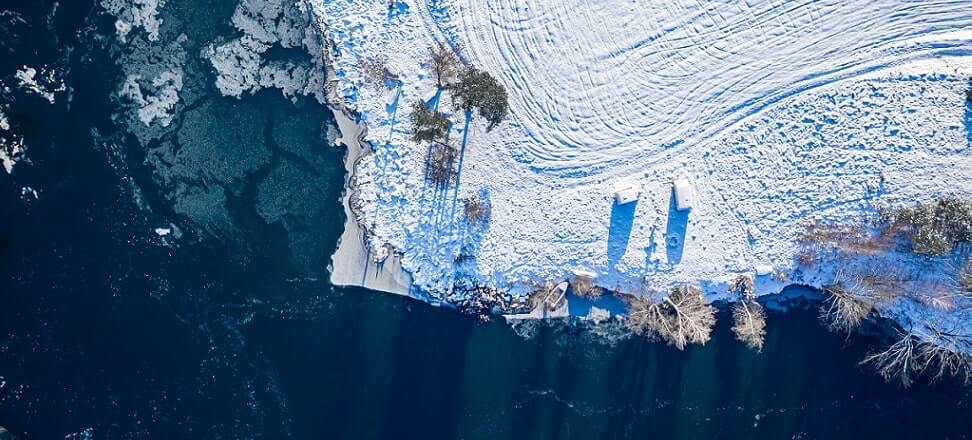All terrestrial ecosystems depend on water, and all organisms inhabit some type of ecosystem. However, it is worth recalling that the basis of this relationship is natural water retention, that is, the temporary holding (retention) of water in various amounts and forms, as well as on different temporal and spatial scales. The variability of the water balance over time is something obvious and natural, but its fluctuations in Poland (on a national scale) have recently reached a significant and alarming scale.
Decline in retention in Poland
The average outflow of water in Poland in 2001-2020 was 56.6 km3, nearly 10 percent lower than the long-term averages of the 20th century: in 1901-2000 it was 61.5 km3, and in 1951-2000 as much as 62.4 km3. Such a significant reduction in outflow values in the first two decades of the 20th century. should probably be linked to an increase in evaporation and non-return agricultural irrigation, and thus to a decrease in underground river recharge during hot weather. This is undoubtedly largely the result of the impact of climate change.
The current water retention potential does not compensate for these losses, nor does it provide the expected flood and drought mitigation retention, including reservoir retention, estimated at about 4.6 km3 (PPNW, 2020). The effects of climate change are leading to an increase in extreme events: heavy precipitation, as well as an increase in the frequency and length of drought periods. In general, this reduces the effectiveness of flood retention (river and urban) and requires compensation in the form of water retention, mainly in vegetation and soil and blue-green infrastructure. In this context, it is worth remembering that every retention is valuable, but not every retention solves the problem.
Retention vs. flood prevention
In assessing the effectiveness of existing retention and considering the need to increase it to reduce flood risk, we must address two types of this risk and their sources and causes. In the first instance, the problem is river flooding, with a significant spatial scale, most often supra-regional, and periodically national. The sources of these floods are most often heavy and prolonged summer precipitation, and the strength of their impact is determined by the vulnerability of the areas at risk.
Recent years have also seen the problem of increasing rapid (flash) urban flooding, mainly rainfall, causing flooding due to the lack of rapid drainage and retention of rain. In addition to dikes and flood control boulevards, reservoir flood retention should also protect us from river flooding, but also urban flooding.
Artificial retention in Poland
In the Program for Counteracting Water Scarcity (PPNW, 2021), the maximum capacity of water reservoirs in Poland is estimated at about 4.6 billioncubic meters, of which:
- 3.5 billioncubic meters of water can be stored by reservoirs, mostly multipurpose,
- Nearly 0.3 billioncubic meters of water can be stored in dry reservoirs and flood control polders.
We have a low capacity for artificial – controlled retention in the country. This is related to the small capacity of the reservoirs in relation to the volume of the river flood wave. The effects of climate change and the shallowing of reservoirs mean that their functionality in reducing the culmination of flood waves, and thus lowering the river flood water table in protected areas, has significantly declined and continues to decline.
Natural retention
An attractive and sought-after alternative to technical flood retention is, of course, technically and technologically supported natural retention. The problem is that it has limited functionality. Effective in protecting against the highest river surges is only “space for rivers,” i.e. maintaining the natural width of the big water valley for long stretches. Afforestation is effective for reducing the impact of the first phase of precipitation, i.e. its effectiveness decreases as the amount of storm precipitation increases. Microretention, which we can also include blue-green infrastructure, is important for reducing frequent and even very frequent calls.
In summary, natural flood retention is effective for:
- river flooding caused by widespread torrential rainfall, if river space and afforestation reduce the risk of flooding in riparian areas;
- urban flooding caused by heavy rainfall, if micro-retention, based on blue-green infrastructure, quantitatively and spatially compensates for excess rainwater runoff discharged through sewers and discharged through storm overflows into rivers.
Retention for drought mitigation
We generally relate the problem of drought to agricultural areas, especially when agricultural crops are at risk. On a regional and local scale, the recognized measure of drought risk is the Agricultural Drought Index, or Climate Water Balance (KBW) value. So far, in agricultural areas, small-scale water retention has been considered an effective way to counteract the effects of drought, and it has been developed without in-depth analysis and evaluation with regard to its effectiveness. PPNW sustains the planning and development of small-scale retention.
Current expert opinions with regard to improving water conditions to combat the effects of drought in agricultural areas, in addition to the development of small-scale retention, direct attention to increasing soil retention through:
- Increasing moisture in the soil profile by upgrading drainage systems, mainly on the basis of delaying runoff and retaining drainage water in local reservoirs;
- Increasing the soil’s retention capacity through agrotechnical methods;
- Intervention irrigation, also using renewable groundwater resources.
Retention in urban areas
In urban areas, the effects of drought are increasingly being felt through the nuisance of heat island formation, which primarily affects health, mainly for the elderly. Current urban-improvement retention solutions are linked to micro-retention and blue-green infrastructure. On a regional and national scale, reconciling retention needs for flood and drought mitigation requires:
- Integrate retention activities aimed at regulating water relations for quantity and protecting resource quality;
- targeting and enhancing retention to reduce the effects of major river flooding, often compounding the effects of urban flooding due to the inability to discharge stormwater into the watercourse;
- to develop an effective irrigation system for agricultural land in times of drought.
Retention for consumption needs
The problem of retention for consumptive use is limited and concerns the maintenance of that part of the water reservoirs that already exist, but not the creation of new ones – due to modern water policies limiting the transfer of water between river basins. Surface intakes of drinking water, however, mostly involve river intakes, while groundwater intakes in the operation of the water supply network account for a large share of the country’s water supply.
What is urgently needed for a real increase in necessary retention?
Development of effective planning, as well as control and periodic evaluation of the implementation effects of retention, which will take into account:
- real – quantitative assessment of the effectiveness of existing and planned retention in relation to spatially and temporally localized needs;
- quantitative assessment of the impacts and synergies of different types of retention at varying spatial scales, from local to regional.
It requires:
- development of study and conceptual work, based on appropriate procedural and methodological regulations (including cost-benefit analysis), supported by research and development projects;
- creation of systemic, interdisciplinary databases – output, outcome, monitoring and control, and dissemination of case-study solutions.
Current plans (e.g., PPNW, 2021) in terms of diagnosis of conditions and total retention at the national and river basin scale are precise, but already in terms of planning they remain only at the level of strategy. This results in recommending the implementation of a huge number of proposals for retention measures/investments made at different times and by different decision-makers without assessing their effectiveness and extent of impact.
The material is based on the content of the article titled. “Flood, drought and consumer retention – how to reconcile them?” published in issue 12/23 of the scientific journal Water Management. Compiled by Matthew Balcerowicz, editor-in-chief. We invite you to read the full article.

 Polski
Polski






